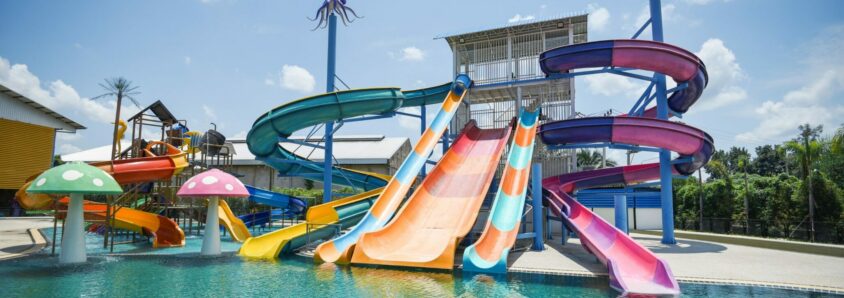Introduction: The Challenges of Owning and Operating a Water Park
Water park owners face a myriad of specific and unique challenges when it comes to safeguarding their operations and ensuring the safety of their guests. From managing potentially hazardous attractions to handling a high volume of visitors, their risk exposures are abundant. For example, the extensive nature of water park facilities, including water slides, wave pools, and lazy rivers, increases the likelihood of accidents and injuries. Additionally, the unpredictable nature of water-related activities can create liability concerns, such as slip and falls, drowning incidents, or equipment malfunctions. In order to adequately address these risks, water parks need specialized insurance coverages that go beyond standard policies. That’s where Prime Insurance Company comes in. As an expert in excess and surplus lines insurance, we offer smart solutions and unique insurance coverages designed specifically for water parks. With our tailored approach, we can help insurance producers provide comprehensive coverage that adequately addresses the distinct needs of water park owners, mitigating their risks and allowing them to focus on providing a safe and enjoyable experience for their guests.
As the summer season approaches every year, water parks are one of the most popular recreational facilities around. It’s a place where families and friends can have fun, bond, and relax. However, safety is a critical issue that must be taken into consideration when managing a water park. Therefore, it is essential to follow proper operational strategies in order to minimize risks and keep your customers safe. Here are some water park risk management tips every water park should follow.
7 Water Park Risk Management Tips
1. Adequate Staffing: Staffing is one of the most significant factors when it comes to risk management in a water park facility. The adequate staffing of lifeguards and pool attendants is crucial to keep guests safe while they enjoy the water park. It is your responsibility as a water park owner to ensure that you have enough lifeguards on duty during peak hours, and their training should be up-to-date. Furthermore, having well-trained employees who can respond swiftly and effectively in the event of an emergency can help prevent accidents from escalating.
2. Compliance with Regulatory Standards: In the water park industry, there are specific regulations set by state, local, and federal authorities to ensure the safety of guests. It is essential to stay up-to-date with these standards and comply with them diligently. Failing to comply with these regulations may result in fines, suspension of permits, or an increased risk of accidents or injuries occurring within your facility. Be proactive in understanding and implementing these regulations to provide a safe environment for your guests.
3. Regular Safety Inspections: Conduct regular safety inspections to identify and address any potential hazards within your water park facility. This includes inspecting equipment, pool decks, slides, and water quality. Keeping detailed records of these inspections can help monitor and maintain the safety of your facility. It is important to promptly address any issues that arise during inspections to prevent accidents and ensure a safe experience for your guests.
4. Proper Safety Signage: Safety signage plays a crucial role in communicating rules and warnings to guests. It should be strategically placed throughout the facility where it is easily visible and understandable to all guests. Clearly display guidelines, such as height restrictions, slide rules, and diving warnings, to help guests make informed decisions and prevent accidents. Additionally, consider using multilingual signage to accommodate a diverse range of visitors.
5. Regular Training: Yearly training is essential for all employees, including lifeguards, attendants, and management staff, to ensure they are up to date with the latest techniques, regulations, and safety procedures in the water park industry. Training should cover topics such as CPR, first aid, emergency response protocols, and crowd management. Encourage ongoing professional development and provide opportunities for continuous training and education to enhance the skills and knowledge of your staff.
6. Emergency Procedure Plan: Develop a comprehensive emergency plan that outlines procedures for any accidents, injuries, or natural disasters that may occur within your facility. This plan should be communicated to all employees and regularly reviewed and updated. Conduct regular training sessions and simulation exercises to ensure that all staff members are familiar with their roles and responsibilities in emergency situations. Additionally, establish clear communication channels with local emergency services to facilitate a swift response if needed.
7. Liability Insurance: One of the most critical water park risk management tips is having liability insurance coverage. Accidents and injuries can happen at any time, and liability insurance will protect your facility from potential lawsuits and cover any associated costs. It provides financial security and peace of mind, allowing you to focus on providing a safe and enjoyable experience for your guests.
Prime Insurance Company offers comprehensive and specialized water park insurance coverage for water parks of all sizes. Our water park coverage offers broad protection for an array of exposures, including general liability, property, and injury protection. We recognize the unique risks specific to water parks and have tailored our coverage to address these challenges. We’re rated “A” by AM Best, and our in-house claims department offers excellent customer service and flexibility. By partnering with Prime Insurance Company, you can ensure that your water park facility is adequately protected.
Risk Management Tips Every Water Park Owner Should Follow
In conclusion, water parks must prioritize the safety of their guests by implementing these water park risk management tips. Adequate staffing, compliance with regulatory standards, regular safety inspections, proper safety signage, regular training of employees, and emergency plans are some fundamental steps required for keeping a safe facility. Lastly, the importance of having liability insurance coverage cannot be overemphasized, and Prime Insurance Company provides one of the best options for water park insurance coverage. As an insurance producer, it is crucial to share these tips with your clients and ensure they have the right coverage in place for their water park facilities. By implementing these risk management strategies, water parks can provide a safe and enjoyable environment for guests to create lasting memories.
Go to our quotes page to request your water park insurance quote!


